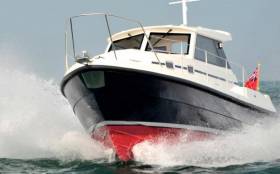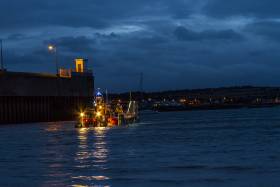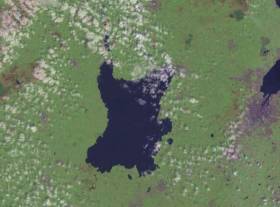Displaying items by tag: Lough Neagh
Arson Attack Destroys Lough Neagh Fishing Co-Op’s New Patrol Boat
#Fishing - “An attack on fishermen” is how the Lough Neagh Fishermen’s Co-operative described the the loss of their new fishing patrol boat by arson, as BelfastLive reports.
The pilot boat was delivered to the co-op only two weeks before the incident in the early hours of Saturday morning (27 January) at the Co Tyrone quay where it was moored.
The PSNI is appealing for information on the arson attack perpetrated by two masked men in the Anneter area of Cookstown shortly after midnight on Friday night.
BelfastLive has more on the story HERE.
Lough Neagh Island’s Lone Resident Says Goodbye After Two Decades As Warden
#LoughNeagh - After two decades as warden of Coney Island in Lough Neagh, Northern Ireland’s ‘Robinson Crusoe’ has sailed on, as the Belfast Telegraph reports.
Peter McClelland won out over 400 applicants in 1998 for the prize position of caretaker of the National Trust-owned island, which has a rich history dating back to Neolithic times.
The Co Antrim man, from nearby Aghagallon, says the last 19 years “were the best years of my life” as he spent his days contentedly alone and occupied by the tasks at hand.
Indeed, from his new home in Portadown, McClelland is planning to write a book about his remarkable experience as the island’s lone resident.
The Belfast Telegraph has more on the story HERE.
Medical Emergency On Lambay Island Prompts Skerries Lifeboat Launch
#RNLI - Skerries RNLI launched yesterday evening (Sunday 22 October) after receiving reports of a medical emergency on Lambay Island.
Shortly after 8.30pm, the alarm was raised by a member of the crew when they received a call from Lambay Island, indicating that a person was unwell and requiring immediate medical assistance.
Skerries RNLI volunteers launched their Atlantic 85 inshore lifeboat Louis Simson with David Knight at the helm and crewed by Steven Johnston, JP Tanner and Jack Keane.
The lifeboat proceeded to the island where they went ashore and began to administer first aid to the casualty — as well as prep a landing area for the Dublin-based Irish Coast Guard helicopter Rescue 116, who transferred the casualty to a waiting ambulance on the mainland for treatment at Beaumont Hospital.
“There were multiple rescue agencies involved in this rescue and it’s great to see everyone working so well together,” said Skerries RNLI lifeboat press officer Gerry Canning. “Our thoughts are with the casualty tonight and we wish them a speedy recovery.”
In other rescue news, PSNI officers have been praised for their “swift action” in saving a man whose car entered Lough Neagh in the early hours of yesterday morning.
As the Belfast Telegraph reports, four officers entered the water to free the man, who was unresponsive, from the partial submerged Volkswagen. He was later transferred to hospital with suspected hypothermia.
Environmentalists In New Challenge Over Lough Neagh Sand Dredging
#LoughNeagh - Friends of the Earth (FoE) is appealing a ruling against its claims that Stormont is “turning a blind eye” to sand dredging in Lough Neagh, as the News Letter reports.
The environmental group brought the issue before the High Court last summer, when it described NI Environment Minister Mark Durkan’s 2015 decision to issue an enforcement notice against sand dredging, rather than an outright ban, as bringing “Northern Ireland into ridicule”.
As much as 1.5 million tonnes of sand is dredged from the lough each year, the charity has claimed, adding that dreading companies have continued the practice as their own challenge against the enforcement notice is pending with the Planning Appeals Commission.
Sand dredging has been carried out in Lough Neagh since the 1930s, and previously no planing permission was required, though the lough was designated as a Special Protection Area for wildlife in 1999.
In November, a judge rejected FoE’s High Court challenge, but the organisation has now appealed that decision.
“We believe the judge erred in law and didn’t take into account the significance of this major nature reserve,” said the charity’s NI director James Orr.
The News Letter has more on the story HERE.
Lough Neagh Joins List Of Top 100 Sustainable Destinations
#Tourism - Lough Neagh joins an exclusive list of 100 ‘sustainable destinations’ after its success in a global tourism competition this week.
As the News Letter reports, the largest inland waterway in the island of Ireland was put forward for evaluation by the Green Destinations Top 100 team, which narrowed down 150 nominees around the world to those taking sustainability most seriously for locals and tourists alike.
Eimear Kearney of the Lough Neagh Partnership was on hand to accept the prestigious designation at the Global Sustainability Competition in Ljubljana, Slovenia.
“For Lough Neagh to be named among the 100 greenest of destinations worldwide is a real achievement,” she said.
The partnership has recently launched a new scheme to improve habitats for protected bird species around the lough, according to BBC News.
The good news for Lough Neagh comes in the same week that a number of maritime tourism operators were featured at the 2016 Irish Responsible Tourism Awards, as previously reported on Afloat.ie.
Lough Neagh Dredging Brings NI 'Into Ridicule'
#LoughNeagh - Environmentalists have branded Northern Ireland a laughing stock for its failure to stop sand dredging in Lough Neagh, as the News Letter reports.
The issue is currently before the High Court after dredging firms appealed NI Environment Minister Mark Durkan's 2015 enforcement notice against the removal of as much as 1.8 million tonnes of sand from Ireland's largest lake.
And the practice has continued unabated, despite planning permission never being granted for sand dredging on the lough, a protected area for wildlife, said Gregory Jones QC on opening the application for judicial review by Friends of the Earth.
“This issue is bringing the planning system in Northern Ireland into ridicule," the charity's counsel told the court. “This is something one would not expect of the most primitive dictatorship.”
The News Letter has more on the story HERE.
Drone Video Reveals Extent Of Lough Neagh Flooding
#LoughNeagh - Drone footage of the dramatic flooding around Lough Neagh has garnered over 7,000 views on YouTube.
According to the News Letter, hundreds have been flocking to the region to see the effects of flood waters as the lough's level reached a 30-year high.
However, any potential benefits in visitor numbers are far outweighed by the severe cost to local businesses, as previously reported on Afloat.ie.
And flooding around the lough will continue to be a problem for the foreseeable future due to a combination of poor water flow control and unreliable long-range weather forecasts.
That was the stark warning from Rivers Agency chief David Potter speaking to a Storming committee earlier this week, as the Belfast Telegraph reports.
"In order to reduce the lough by a foot, we need between 25 and 38 days' notice, and after about five days our level of confidence in the weather forecast is pretty shaky," he said.
"Hopefully that describes the dilemma that we are in. We can't anticipate to the extent that people believe we can."
Meanwhile, a meeting in Brussels this week has dismissed as a myth the notion that EU regulations have prevented flood relief in Co Galway, which is still suffering the effect of December's winter storms.
As Galway Bay FM reports, MEP Marian Harkin revealed that Ireland has made only one application for works of overriding public interest in the last 20 years, as the vast majority of decisions are taken at member state level.
Business Count Cost Of Lough Neagh Flooding
#Flooding - Water levels on Lough Neagh are at a 30-year high, and business owners in the region are counting the cost of flooding on their livelihoods, as Belfast Live reports.
A number of traders are battling to stay open despite the deluge, which came after the wettest December on record.
And the rainy trend shows no sign of letting up, with showers forecast every day till early next week.
"We're still open but nobody can get in to us," said David Cochrane of Custom Covers NI, who is keeping his new Kinnego Marina unit open despite five inches of flood waters.
"It's a bit of a mess to say the least. The financial side of it has cost me a lot."
Yesterday BBC NI weatherman Barra Best posted video of the damaging flooding at the marina on the southern end of Ireland's largest lake.
Lough Neagh Flooding Woes Set To Continue
#Flooding - BBC NI weatherman Barra Best has posted video to Twitter showing some of the damaging flooding at Kinnego Marina – home of Lough Neagh Sailing Club – on the southern shores of Lough Neagh near Lurgan.
And local business are braced for worse to come with further heavy rains forecast for later this evening (Wednesday 6 January), persisting overnight across Leinster and Ulster according to the latest Met Éireann forecast.
#LoughNeagh - Families who have worked for generations in eel farming on Lough Neagh - putting the region on the map for its world-renowned eels – fear they are being pushed out of the industry by "unfair" policies, say campaigners.
And as Belfast Live reports, the authorities in charge of eel permits have also been accused of refusing to renew existing licences.
The Lough Neagh United Fishermen, or LNUF, says many long-time eel fishing families "grew up with the assurance that [they] would be 'looked after'".
Spokesperson Brian Wylie says his group's members also hold shares in the Lough Neagh Fishermen's Co-operative Society Ltd, which is authorised to issue permits for eel fishing.
"Our members are being ignored [by the co-operative] on a yearly basis, and can clearly see permits being handed out to people and their families never were involved in the ethos or concept," he adds.
Belfast Live has more on the story HERE.



































































